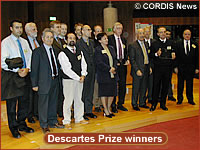MS and gamma ray bursts research projects share Descartes Prize
The two winners of this year's Descartes Prize - a project developing new drugs for Multiple Sclerosis (MS) sufferers and a project that has discovered the origins of gamma ray bursts - were announced on 5 December. Each project consortium will receive 500,000 euro. The Descartes Prize is awarded to scientific projects which have involved pan-European collaboration and that are addressing the concerns of citizens while contributing to Europe's competitiveness. The two winners were selected from a shortlist of 10 by a Grand Jury. These 10 projects were, in turn, chosen from 108 applications - the highest number so far in the three year history of the prize. 'The vintage of 2002 is an excellent one. It shows that our continent is still out there with the best of them,' said Yves Michot, chairman of the jury and former president of Aerospatiale Matra. Professor Lars Fugger from Aarhus University Hospital in Copenhagen, Denmark, collected the prize for a project tackling MS. The project is being led by Professor Fugger and has partner teams in Denmark, Sweden, the UK and the USA. Professor Fugger described himself as feeling 'very honoured' and accepted the prize 'on behalf of all the EU citizens who suffer from Multiple Sclerosis.' The project seeks to understand what makes the immune system cause MS by attacking a patient's nerve cells instead of invading micro-organisms. Their discoveries have increased understanding of the disease, which has so far evaded a cure, and are helping to create new drugs to tackle the disease. MS affects one in every thousand Europeans and has recently become more widespread in young women. 'We must get pharmaceutical companies interested in producing drugs for them [the sufferers],' said Professor Fugger. The prize winner claimed to have been optimistic regarding his projects chances of winning, as he knew that 'we had a good project which is important for European citizens and demonstrates excellence and added value,' he told CORDIS News. The 500,000 euro will be used to extend what the consortium is already doing and to further understand the disease process, according to Professor Fugger. He refuses however to estimate when new drugs resulting from the project will be available on the market, saying that it is an unpredictable process and that he does not want to raise the hopes of MS sufferers only to have to let them down when a date is not met. Less optimistic about his chances of picking up a prize was Edward Van den Heuvel from the University of Amsterdam, the second prize winner and coordinator of a project investigating the origin of gamma ray bursts. 'I was told that the prize was only given to 'useful' projects, so I am very happy that the jury has chosen fundamental science,' said Dr Van den Heuvel. 'We cannot claim to be doing anything useful right now,' he continued. Chairman of the Grand Jury, Yves Michot, dismissed this statement however, saying that it is impossible to compare the usefulness of projects. Discussions within the jury enabled the members to decide where the real breakthroughs had been made, and this was why the project was selected, said Mr Michot. He added that the jury had considered 'not only that they had found out where the rays come form, but that they are helping future scientists.' While there is no direct application for the results of Dr Van den Heuvel's project today, there could be in the future. Gamma ray bursts were first discovered over 30 years ago, but their origin was unknown. This project has established that gamma ray bursts come from huge explosions generated by the collapse of very large, distant stars. So far, such explosions have only been seen in other galaxies, but if they happen in our own galaxy, they could be very dangerous, explained Dr Van den Heuvel. The project brings together teams from the Netherlands, Italy, Denmark, Spain, the UK and Germany. Fundamental to the project is the BeppoSAX satellite, developed jointly by Italy and the Netherlands. 'Good collaboration was essential,' said Dr Van den Heuvel. 'This work demanded rapid response from a large number of teams covering many different observation techniques, at wavelengths from radio to gamma rays, on the ground and in space. No EU country on its own could muster the expertise to do this,' he said. Dr Van den Heuvel expressed his 'joy and happiness' at receiving the reward and paid tribute to J A van Paradijs, the previous project coordinator, who passed away three years ago: 'Without him, I would not be standing here,' he said. The Dutch prizewinner noted that the day of the award ceremony was St Nicholas' Day. 'In my country, everybody gets a present,' he said, expressing his satisfaction with his own 'present'. Representing EU Research Commissioner Philippe Busquin at the event, who was in Brussels seeking to negotiate the inclusion of a chapter on research and innovation in the European Convention, was Rainer Gerold, Director of science and society in the Commission's Research DG. Dr Gerold described the prize as a 'stimulus for the teams and for public interest in science, which is one of the key objectives of the Commission.' He announced that the Commission is currently discussing a future prize for science communication. The decision to have such a prize has been taken, he explained, but the conditions are yet to be determined.



